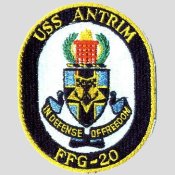ANTRIM FFG 20: Difference between revisions
JonBurdett (talk | contribs) (added 1 mark replaced 1) |
JonBurdett (talk | contribs) (PO dates moved covers) |
||
| Line 32: | Line 32: | ||
</ol></td> | </ol></td> | ||
<td align="center" width="220" valign="top"> | <td align="center" width="220" valign="top"> | ||
[[Image:ANTRIM FFG PATCH.jpg|thumb|center| | [[Image:ANTRIM FFG PATCH.jpg|thumb|center|200px]] | ||
</td> | </td> | ||
</tr> | </tr> | ||
| Line 48: | Line 48: | ||
range for covers on that page. | range for covers on that page. | ||
<ol> | <ol> | ||
<li>[[USS ANTRIM FFG 20_Covers_Page_1 | Covers Page 1 ]] ( | <li>[[USS ANTRIM FFG 20_Covers_Page_1 | Covers Page 1 ]] (1978-96)</li> | ||
</ol> | </ol> | ||
<p> </p> | <p> </p> | ||
| Line 77: | Line 77: | ||
<th align="center" width="120">Thumbnail Link To<br/>Full Cover Image</th> | <th align="center" width="120">Thumbnail Link To<br/>Full Cover Image</th> | ||
</tr></table> | </tr></table> | ||
<!-- | |||
<!-- | <!-- ********************************************** --> | ||
<!-- | <!-- Postmarks from 1st Post Office Period --> | ||
< | <!-- ********************************************** --> | ||
<hr/> | |||
<h4>Post Office Established September 26 1981 - Disestablished 1996</h4> | |||
< | |||
</ | |||
<!-- ============== --> | <!-- ============== --> | ||
| Line 99: | Line 89: | ||
<br/> <br/><table width="95%" border="1" cellpadding="5" cellspacing="0"> | <br/> <br/><table width="95%" border="1" cellpadding="5" cellspacing="0"> | ||
<tr><td align="center" valign="center" width="140"> | <tr><td align="center" valign="center" width="140"> | ||
Locy Type<br/>FDC 2-1(n+) | Locy Type<br/>FDC 2-1(n+) Sep 26, 1981 | ||
</td><td align="center" valign="center" width="100"> | </td><td align="center" valign="center" width="100"> | ||
1981-09-26 | 1981-09-26 | ||
| Line 114: | Line 104: | ||
<br/> <br/><table width="95%" border="1" cellpadding="5" cellspacing="0"> | <br/> <br/><table width="95%" border="1" cellpadding="5" cellspacing="0"> | ||
<tr><td align="center" valign="center" width="140"> | <tr><td align="center" valign="center" width="140"> | ||
Locy Type<br/>2-1(n+) | Locy Type<br/>2-1(n+) (D1,USN,USS) | ||
</td><td align="center" valign="center" width="100"> | </td><td align="center" valign="center" width="100"> | ||
1983-06-16 | 1983-06-16 | ||
| Line 156: | Line 146: | ||
[[Cachet_Category_Port_Visit_ | Port Visit]]<br/>[[Cachet_Maker_USCS_Chapter_4_Stephen_Decatur_ | Stephen Decatur Chapter No. 4, USCS]] | [[Cachet_Category_Port_Visit_ | Port Visit]]<br/>[[Cachet_Maker_USCS_Chapter_4_Stephen_Decatur_ | Stephen Decatur Chapter No. 4, USCS]] | ||
<!-- === End of Postmark Entry === --> | <!-- === End of Postmark Entry === --> | ||
<p> </p> | <p> </p> | ||
<h3>Other Information</h3> | <h3>Other Information</h3> | ||
Awards, Citations and Campaign Ribbons...<br/> | Awards, Citations and Campaign Ribbons...<br/> | ||
Navy Meritorious Unit Commendation | Navy Meritorious Unit Commendation - CG Meritorious Unit Commendation - Navy E Ribbon /4 - National Defense Service Medal - Armed Forces Expeditionary Medal - Navy Sea Service Deployment Ribbon - CG Special Operations Service Ribbon w/2 stars<br/><br/> | ||
'''NAMESAKE''' - Richard Nott Antrim (December 17 1907 - March 7 1969)<br/> | '''NAMESAKE''' - Richard Nott Antrim (December 17 1907 - March 7 1969)<br/> | ||
Antrim entered The Naval Academy in 1927, graduating on June 4 1931. He served briefly in the llth Naval District before reporting to [[NEW YORK BB 34|USS NEW YORK BB-34]] as fire control officer. Detached in April 1932, he received flight instruction at NAS Pensacola FL before serving in [[SALINAS AO 19|USS SALINAS AO-19]], [[NITRO AE 2|USS NITRO AE-2]], and [[TRENTON CL 11|USS TRENTON CL-11]]. Ordered to Quincy MA he assisted in fitting out [[PORTLAND CA 33|USS PORTLAND CA-33]] and served in her until the spring of 1936. He became Assistant 1st Lieutenant in [[CROWNINSHIELD DD 134|USS CROWNINSHIELD DD-134]] before undergoing instruction in lighter-than-air flight at NAS Lakehurst NJ, receiving his naval aviator (LTA) designation. In the spring of 1938, Antrim arrived on the Asiatic Station and served as XO of [[BITTERN AM 36|USS BITTERN AM-36]] before joining [[POPE DD 225|USS POPE DD-225]] as XO in December 1939. The outbreak of war in the Pacific in December 1941 found Antrim still serving in that capacity. During her brief wartime career, POPE played a significant part in two major engagements fought by the Asiatic Fleet destroyers; the Battle of Makassar Strait and the Battle of Badoeng Strait, as well as in the last act following the Battle of the Java Sea. In the former, Pope delivered close-range attacks that delayed the Japanese landings at Balikpapan. During the action, Lt. Antrim "cooly selected targets for his guns and torpedoes, placing his shots so accurately in the midst of a large Japanese convoy" and thus inflicting damage to several enemy ships. After the Battle of Badoeng Strait, Pope's CO, Cdr. Welford C. Blinn, reported that Antrim was "highly deserving of commendation" citing Antrim as a "ready assistant in navigation, fire control, and torpedo fire," Blinn recommended him not only for a destroyer command but for a "decoration deemed appropriate." Antrim later received a Navy Cross for this service. The Battle of the Java Sea (27 to 28 February 1942) ended all Allied hope of stemming the Japanese onslaught. The smashed Allied fleet attempted to escape the Japanese warships tightening the noose around Java. Among the small groups was one composed of HMS EXETER, the destroyer HMS ENCOUNTER, and POPE. The ships slipped out of Surabaya, Java, on the evening of February 28, but were spotted the next day by Japanese aircraft. A surface force of cruisers and destroyers located the fleeing trio, and a fierce action ensued, with EXETER and ENCOUNTER going down. POPE, however, fought on, managing to make a temporary haven in a passing rain squall. Unfortunately, the destroyer—one of those Asiatic Fleet flushdeckers "old enough to vote"—could not elude her pursuers. Ultimately, damaged by Japanese bombs, from aircraft summoned from the carrier RYUJO, and by shells from the Japanese force, POPE began to sink, but not before all but one of her men had reached safety in life rafts and the destroyer's sole motor whaleboat. Antrim, wounded in the action, helped to gather the life rafts around the boat to facilitate the distribution of what meager supplies were available to the men. His devotion to duty during the ordeal inspired and sustained his shipmates' morale. For three days and nights, POPE's survivors doggedly stuck together as a group until picked up by a Japanese warship and transferred to Japanese Army authorities at Makassar, in the Celebes. There, Antrim performed an unforgettable act of personal bravery. During the early part of his imprisonment at Makassar in April 1942, he saw a Japanese guard brutally beating a fellow prisoner of war (POW) and boldly intervened, attempting to quiet and reason with the guard, as others, and some 2,000 POW's closed in about the scene. However, the Japanese ignored Antrim's entreaties and continued beating the prisoner unmercifully. After receiving some 15 blows with a hawser and the kicks of three other guards, the victim was almost insensible. At that instant, Antrim stepped forward. The expressions of the Japanese changed to incredulity as the Lieutenant volunteered to take the remainder of the battered man's punishment. This action threw his captors off balance and drew a roar of acclaim from the Allied POW's gathered around. Antrim's stand, while saving the life of the other man, also saved his own and won new respect for the American officers and men. Later, his leadership in serving as a spokesman for his fellow POW's earned them an improvement in camp living conditions. For his conspicuous act of valor at Makassar in the spring of 1942, Antrim later received The Medal of Honor. Subsequently, when the Japanese forced Antrim to take charge of a labor detail assigned the task of constructing slit trenches for protection during air raids, he carefully rearranged the construction work plans approved by the Japanese and gained their approval of his own ideas. Under the eyes of their captors, the POW's dug the slit trenches all right, but in a curious pattern recognizable from the air as a giant "U.S." which clearly and craftily identified the occupants of the trenches. This audacious action possibly saved hundreds of prisoners of war from mistaken bombings by Allied planes. Antrim carried out the plan in spite of the fact that discovery of his trick would have resulted in instant beheading! For that alteration of construction work, Antrim received a Bronze Star. Ultimately liberated after the war in the Far East ended in August 1945, Antrim returned to the United States and enjoyed rehabilitation leave before attending the Repatriated POW Refresher Course at the Washington Navy Yard, Washington, D.C., in May 1946. He then brushed up on his pilot training at NAS, Lakehurst, and later completed a course at the Naval War College. The valient officer who had been listed as missing since the sinking of Pope in March 1942 received The Medal of Honor and Bronze Star from President Harry S. Truman in ceremonies at the White House on January 30 1947. Later, following a brief stint at the Fleet Sonar School, San Diego, Calif., in June and July 1947, Antrim went to sea in command of the destroyer [[TURNER DDR 834|USS TURNER DD-834]]. He next underwent further instruction at NAS, Lakehurst, before assuming the duties of Assistant for Lighter-than-Air Planning and Programs, Office of the Chief of Naval Operations (CNO), Washington, D.C., in December 1948. Following further Washington duty with the Policy Advisory Staff, Department of State, and the Psychological Strategy Board Antrim commanded the Attack Transport [[MONTROSE LPA 212|USS MONTROSE APA-212]] before returning to the capital for a brief tour of duty as Head, Amphibious Warfare Matters Section, Office of the CNO, prior to his retirement on April 1 1954. He was advanced to Rear Admiral on the retired list on the basis of his combat awards. Rear Admiral Antrim died on March 7 1969 in Mountain Home, Arkansas. | Antrim entered The Naval Academy in 1927, graduating on June 4 1931. He served briefly in the llth Naval District before reporting to [[NEW YORK BB 34|USS NEW YORK BB-34]] as fire control officer. Detached in April 1932, he received flight instruction at NAS Pensacola FL before serving in [[SALINAS AO 19|USS SALINAS AO-19]], [[NITRO AE 2|USS NITRO AE-2]], and [[TRENTON CL 11|USS TRENTON CL-11]]. Ordered to Quincy MA he assisted in fitting out [[PORTLAND CA 33|USS PORTLAND CA-33]] and served in her until the spring of 1936. He became Assistant 1st Lieutenant in [[CROWNINSHIELD DD 134|USS CROWNINSHIELD DD-134]] before undergoing instruction in lighter-than-air flight at NAS Lakehurst NJ, receiving his naval aviator (LTA) designation. In the spring of 1938, Antrim arrived on the Asiatic Station and served as XO of [[BITTERN AM 36|USS BITTERN AM-36]] before joining [[POPE DD 225|USS POPE DD-225]] as XO in December 1939. The outbreak of war in the Pacific in December 1941 found Antrim still serving in that capacity. During her brief wartime career, POPE played a significant part in two major engagements fought by the Asiatic Fleet destroyers; the Battle of Makassar Strait and the Battle of Badoeng Strait, as well as in the last act following the Battle of the Java Sea. In the former, Pope delivered close-range attacks that delayed the Japanese landings at Balikpapan. During the action, Lt. Antrim "cooly selected targets for his guns and torpedoes, placing his shots so accurately in the midst of a large Japanese convoy" and thus inflicting damage to several enemy ships. After the Battle of Badoeng Strait, Pope's CO, Cdr. Welford C. Blinn, reported that Antrim was "highly deserving of commendation" citing Antrim as a "ready assistant in navigation, fire control, and torpedo fire," Blinn recommended him not only for a destroyer command but for a "decoration deemed appropriate." Antrim later received a Navy Cross for this service. The Battle of the Java Sea (27 to 28 February 1942) ended all Allied hope of stemming the Japanese onslaught. The smashed Allied fleet attempted to escape the Japanese warships tightening the noose around Java. Among the small groups was one composed of HMS EXETER, the destroyer HMS ENCOUNTER, and POPE. The ships slipped out of Surabaya, Java, on the evening of February 28, but were spotted the next day by Japanese aircraft. A surface force of cruisers and destroyers located the fleeing trio, and a fierce action ensued, with EXETER and ENCOUNTER going down. POPE, however, fought on, managing to make a temporary haven in a passing rain squall. Unfortunately, the destroyer—one of those Asiatic Fleet flushdeckers "old enough to vote"—could not elude her pursuers. Ultimately, damaged by Japanese bombs, from aircraft summoned from the carrier RYUJO, and by shells from the Japanese force, POPE began to sink, but not before all but one of her men had reached safety in life rafts and the destroyer's sole motor whaleboat. Antrim, wounded in the action, helped to gather the life rafts around the boat to facilitate the distribution of what meager supplies were available to the men. His devotion to duty during the ordeal inspired and sustained his shipmates' morale. For three days and nights, POPE's survivors doggedly stuck together as a group until picked up by a Japanese warship and transferred to Japanese Army authorities at Makassar, in the Celebes. There, Antrim performed an unforgettable act of personal bravery. During the early part of his imprisonment at Makassar in April 1942, he saw a Japanese guard brutally beating a fellow prisoner of war (POW) and boldly intervened, attempting to quiet and reason with the guard, as others, and some 2,000 POW's closed in about the scene. However, the Japanese ignored Antrim's entreaties and continued beating the prisoner unmercifully. After receiving some 15 blows with a hawser and the kicks of three other guards, the victim was almost insensible. At that instant, Antrim stepped forward. The expressions of the Japanese changed to incredulity as the Lieutenant volunteered to take the remainder of the battered man's punishment. This action threw his captors off balance and drew a roar of acclaim from the Allied POW's gathered around. Antrim's stand, while saving the life of the other man, also saved his own and won new respect for the American officers and men. Later, his leadership in serving as a spokesman for his fellow POW's earned them an improvement in camp living conditions. For his conspicuous act of valor at Makassar in the spring of 1942, Antrim later received The Medal of Honor. Subsequently, when the Japanese forced Antrim to take charge of a labor detail assigned the task of constructing slit trenches for protection during air raids, he carefully rearranged the construction work plans approved by the Japanese and gained their approval of his own ideas. Under the eyes of their captors, the POW's dug the slit trenches all right, but in a curious pattern recognizable from the air as a giant "U.S." which clearly and craftily identified the occupants of the trenches. This audacious action possibly saved hundreds of prisoners of war from mistaken bombings by Allied planes. Antrim carried out the plan in spite of the fact that discovery of his trick would have resulted in instant beheading! For that alteration of construction work, Antrim received a Bronze Star. Ultimately liberated after the war in the Far East ended in August 1945, Antrim returned to the United States and enjoyed rehabilitation leave before attending the Repatriated POW Refresher Course at the Washington Navy Yard, Washington, D.C., in May 1946. He then brushed up on his pilot training at NAS, Lakehurst, and later completed a course at the Naval War College. The valient officer who had been listed as missing since the sinking of Pope in March 1942 received The Medal of Honor and Bronze Star from President Harry S. Truman in ceremonies at the White House on January 30 1947. Later, following a brief stint at the Fleet Sonar School, San Diego, Calif., in June and July 1947, Antrim went to sea in command of the destroyer [[TURNER DDR 834|USS TURNER DD-834]]. He next underwent further instruction at NAS, Lakehurst, before assuming the duties of Assistant for Lighter-than-Air Planning and Programs, Office of the Chief of Naval Operations (CNO), Washington, D.C., in December 1948. Following further Washington duty with the Policy Advisory Staff, Department of State, and the Psychological Strategy Board Antrim commanded the Attack Transport [[MONTROSE LPA 212|USS MONTROSE APA-212]] before returning to the capital for a brief tour of duty as Head, Amphibious Warfare Matters Section, Office of the CNO, prior to his retirement on April 1 1954. He was advanced to Rear Admiral on the retired list on the basis of his combat awards. Rear Admiral Antrim died on March 7 1969 in Mountain Home, Arkansas. | ||
Latest revision as of 05:40, 25 April 2017
Ship Name and Designation History
This section lists the names and designations that the ship had during its lifetime. The list is in chronological order.
This section lists active links to the pages displaying covers associated with the ship. There should be a separate set of pages for each incarnation of the ship (ie, for each entry in the "Ship Name and Designation History" section). Covers should be presented in chronological order (or as best as can be determined).
Since a ship may have many covers, they may be split among many pages so it doesn't take forever for the pages to load. Each page link should be accompanied by a date range for covers on that page.
- Covers Page 1 (1978-96)
Postmarks
This section lists examples of the postmarks used by the ship. There should be a separate set of postmarks for each incarnation of the ship (ie, for each entry in the "Ship Name and Designation History" section). Within each set, the postmarks should be listed in order of their classification type. If more than one postmark has the same classification, then they should be further sorted by date of earliest known usage.
A postmark should not be included unless accompanied by a close-up image and/or an
image of a cover showing that postmark. Date ranges MUST be based ONLY ON COVERS IN
THE MUSEUM and are expected to change as more covers are added.
>>> If you have a better example for any of the postmarks, please feel free to replace the
existing example.
|
Postmark Type |
Date From to Date To |
Thumbnail Link To Close-Up Image |
Thumbnail Link To Full Cover Image |
|---|
Post Office Established September 26 1981 - Disestablished 1996
|
Locy Type |
1981-09-26 |
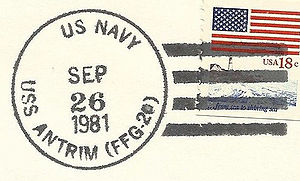 |
 |
First Day in Commission
|
Locy Type |
1983-06-16 |
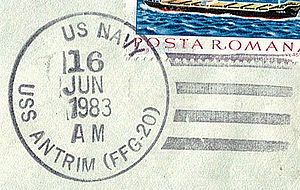 |
 |
Posted from Romania
|
Locy Type |
1984-10-04 |
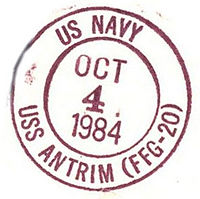 |
 |
Note:
|
USPS Pictorial |
1988-07-07 |
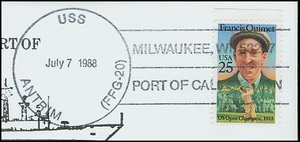 |
 |
Port Visit
Stephen Decatur Chapter No. 4, USCS
Other Information
Awards, Citations and Campaign Ribbons...
Navy Meritorious Unit Commendation - CG Meritorious Unit Commendation - Navy E Ribbon /4 - National Defense Service Medal - Armed Forces Expeditionary Medal - Navy Sea Service Deployment Ribbon - CG Special Operations Service Ribbon w/2 stars
NAMESAKE - Richard Nott Antrim (December 17 1907 - March 7 1969)
Antrim entered The Naval Academy in 1927, graduating on June 4 1931. He served briefly in the llth Naval District before reporting to USS NEW YORK BB-34 as fire control officer. Detached in April 1932, he received flight instruction at NAS Pensacola FL before serving in USS SALINAS AO-19, USS NITRO AE-2, and USS TRENTON CL-11. Ordered to Quincy MA he assisted in fitting out USS PORTLAND CA-33 and served in her until the spring of 1936. He became Assistant 1st Lieutenant in USS CROWNINSHIELD DD-134 before undergoing instruction in lighter-than-air flight at NAS Lakehurst NJ, receiving his naval aviator (LTA) designation. In the spring of 1938, Antrim arrived on the Asiatic Station and served as XO of USS BITTERN AM-36 before joining USS POPE DD-225 as XO in December 1939. The outbreak of war in the Pacific in December 1941 found Antrim still serving in that capacity. During her brief wartime career, POPE played a significant part in two major engagements fought by the Asiatic Fleet destroyers; the Battle of Makassar Strait and the Battle of Badoeng Strait, as well as in the last act following the Battle of the Java Sea. In the former, Pope delivered close-range attacks that delayed the Japanese landings at Balikpapan. During the action, Lt. Antrim "cooly selected targets for his guns and torpedoes, placing his shots so accurately in the midst of a large Japanese convoy" and thus inflicting damage to several enemy ships. After the Battle of Badoeng Strait, Pope's CO, Cdr. Welford C. Blinn, reported that Antrim was "highly deserving of commendation" citing Antrim as a "ready assistant in navigation, fire control, and torpedo fire," Blinn recommended him not only for a destroyer command but for a "decoration deemed appropriate." Antrim later received a Navy Cross for this service. The Battle of the Java Sea (27 to 28 February 1942) ended all Allied hope of stemming the Japanese onslaught. The smashed Allied fleet attempted to escape the Japanese warships tightening the noose around Java. Among the small groups was one composed of HMS EXETER, the destroyer HMS ENCOUNTER, and POPE. The ships slipped out of Surabaya, Java, on the evening of February 28, but were spotted the next day by Japanese aircraft. A surface force of cruisers and destroyers located the fleeing trio, and a fierce action ensued, with EXETER and ENCOUNTER going down. POPE, however, fought on, managing to make a temporary haven in a passing rain squall. Unfortunately, the destroyer—one of those Asiatic Fleet flushdeckers "old enough to vote"—could not elude her pursuers. Ultimately, damaged by Japanese bombs, from aircraft summoned from the carrier RYUJO, and by shells from the Japanese force, POPE began to sink, but not before all but one of her men had reached safety in life rafts and the destroyer's sole motor whaleboat. Antrim, wounded in the action, helped to gather the life rafts around the boat to facilitate the distribution of what meager supplies were available to the men. His devotion to duty during the ordeal inspired and sustained his shipmates' morale. For three days and nights, POPE's survivors doggedly stuck together as a group until picked up by a Japanese warship and transferred to Japanese Army authorities at Makassar, in the Celebes. There, Antrim performed an unforgettable act of personal bravery. During the early part of his imprisonment at Makassar in April 1942, he saw a Japanese guard brutally beating a fellow prisoner of war (POW) and boldly intervened, attempting to quiet and reason with the guard, as others, and some 2,000 POW's closed in about the scene. However, the Japanese ignored Antrim's entreaties and continued beating the prisoner unmercifully. After receiving some 15 blows with a hawser and the kicks of three other guards, the victim was almost insensible. At that instant, Antrim stepped forward. The expressions of the Japanese changed to incredulity as the Lieutenant volunteered to take the remainder of the battered man's punishment. This action threw his captors off balance and drew a roar of acclaim from the Allied POW's gathered around. Antrim's stand, while saving the life of the other man, also saved his own and won new respect for the American officers and men. Later, his leadership in serving as a spokesman for his fellow POW's earned them an improvement in camp living conditions. For his conspicuous act of valor at Makassar in the spring of 1942, Antrim later received The Medal of Honor. Subsequently, when the Japanese forced Antrim to take charge of a labor detail assigned the task of constructing slit trenches for protection during air raids, he carefully rearranged the construction work plans approved by the Japanese and gained their approval of his own ideas. Under the eyes of their captors, the POW's dug the slit trenches all right, but in a curious pattern recognizable from the air as a giant "U.S." which clearly and craftily identified the occupants of the trenches. This audacious action possibly saved hundreds of prisoners of war from mistaken bombings by Allied planes. Antrim carried out the plan in spite of the fact that discovery of his trick would have resulted in instant beheading! For that alteration of construction work, Antrim received a Bronze Star. Ultimately liberated after the war in the Far East ended in August 1945, Antrim returned to the United States and enjoyed rehabilitation leave before attending the Repatriated POW Refresher Course at the Washington Navy Yard, Washington, D.C., in May 1946. He then brushed up on his pilot training at NAS, Lakehurst, and later completed a course at the Naval War College. The valient officer who had been listed as missing since the sinking of Pope in March 1942 received The Medal of Honor and Bronze Star from President Harry S. Truman in ceremonies at the White House on January 30 1947. Later, following a brief stint at the Fleet Sonar School, San Diego, Calif., in June and July 1947, Antrim went to sea in command of the destroyer USS TURNER DD-834. He next underwent further instruction at NAS, Lakehurst, before assuming the duties of Assistant for Lighter-than-Air Planning and Programs, Office of the Chief of Naval Operations (CNO), Washington, D.C., in December 1948. Following further Washington duty with the Policy Advisory Staff, Department of State, and the Psychological Strategy Board Antrim commanded the Attack Transport USS MONTROSE APA-212 before returning to the capital for a brief tour of duty as Head, Amphibious Warfare Matters Section, Office of the CNO, prior to his retirement on April 1 1954. He was advanced to Rear Admiral on the retired list on the basis of his combat awards. Rear Admiral Antrim died on March 7 1969 in Mountain Home, Arkansas.
If you have images or information to add to this page, then either contact the Curator or edit this page yourself and add it. See Editing Ship Pages for detailed information on editing this page.
Copyright 2024 Naval Cover Museum
